Household CO2 Emissions: Current Status and Future Perspectives
Abstract
1. Introduction
2. Bibliometric Data and Methodology
3. Research Findings
3.1. Research Status
3.1.1. Overall Publishing Trend
3.1.2. Journal Outlets of the Paper
3.1.3. Contributions of Countries/Territories
3.1.4. Research Category
3.1.5. Hotspots
3.2. Research Review
3.2.1. Research Subjects
3.2.2. Research Methods
3.2.3. Influencing Factors of HCEs
- The demographic factors of HCEs are analyzed from the perspective of the population structure (such as the gender and age structure), population density (such as housing density and land density), and population quantity (such as household size, total population, and urbanization). The assessment of India by Rosenberg et al. showed that women were neither the only nor the main beneficiaries of electricity [46]. Ota et al. noted that the aging of society and the population both decreased and increased Japan’s electricity demand but did not increase or decrease its gas demand, respectively [34]. Chancel showed that baby boomers in France emitted more HCEs than other generations, while there were no generational effect in the USA [47]. Yu et al. noted that as consumption patterns changed, the shift to smaller and aging households produced more household energy usage and carbon emissions [48]. Different researchers have different views on this mechanism of HCEs.
- The income factors of HCEs include the income level (such as income per household, income per capita, and total income) and the consumption level (such as consumption ability and consumption tendency). Some results show that income and consumption play an important role in increasing HCEs. For example, an increase in per capita income resulted in increased HCEs in China [21,45,49], Ireland [50], France, and the USA [47]. Wiedenhofer et al. and Wu et al. showed that there was inequality in household carbon emissions and household energy usage [25,38]. The C40 Cities indicates that global GHG emissions mainly come from urban consumption [51].
- The social factors of HCEs include economic development (such as total GDP and GDP per capita), the education level (such as the number of educated people and the number of universities), and lifestyle (such as culture and social awareness). Some arguments emphasize that more energy usage and related HCEs increase as the economy grows [45]. Li et al. reviewed HCEs on a scale of social awareness and lifestyle, which play important roles in HCEs [52]. Hafner et al. found that promoting behaviors such as social norms and habits could reduce HCEs from thermal energy demand [53]. Sköld et al. found that people needed to carry out a moderate change in their lifestyle in regard to mobility, which could help to achieve a substantial reduction of 50% [54]. Meangbua et al. showed that in Thailand, education positively impacted direct household CO2 requirements and negatively impacted indirect household CO2 requirements [55]. Therefore, social factors have different impacts on HCEs.
- The technological factors of HCEs include emission intensity (such as HCEs per unit GDP and HCEs per unit consumption) and technology application (such as innovation, investment, and professional skill). Some have argued that higher living standards and technology levels led to higher per capita household energy consumption due to the potential rebound effect in energy efficiency and technology [56]. However, others have disagreed [57]. Asumadu-Sarkodie et al. argued that low carbon technology and cleaner energy transition could help to alleviate environmental pollution [57].
- The policy factors of HCEs include incentives (such as encouraging subsidy policies and political policies) and punitive policies (such as punitive subsidy policies and political policies). An analysis of the carbon footprint of the welfare state shows that green investments can reduce the carbon footprint with no unnecessary rebound effects [58]. Zhang et al. summarized incentive measures and punitive measures for HCEs and found that different local environmental policies for HCEs in different countries, regions, provinces and cities were crucial for energy conservation and carbon emission reduction [27].
- The natural factors of HCEs include resources (such as water and land), the environment (such as the air quality index (AQI) and refuse disposal), climate (such as local climate and extreme climate), and energy (such as direct energy usage and indirect energy consumption). Studies on the impact of natural factors on HCEs have mainly focused on the relationships among HCEs and climate change. For example, Nie et al. found that the climate effects caused by abnormal temperatures led to income growth, which led to the use of more household energy consumption and the production of more HCEs [59].
4. Discussion and Conclusions
4.1. Future Perspectives and Discussion
4.1.1. More Micro-Level Research on HCEs and Further In-Depth Mining
4.1.2. Comparative Analysis of the Differences in HCEs Is a Future Direction
4.1.3. Emission Reduction Measures Need to Be Localized
4.1.4. Limitations
5. Conclusions
- We find that research on HCEs has shown a rapid and active trend over the last 30 years that is highly consistent with national action on climate change and carbon emission reduction. After the Copenhagen Accord in 2009, the number of HCE papers published in 2010 increased significantly. From the perspective of country contributions, research on HCEs is mainly performed by China, the USA, and the UK. It is necessary to strengthen the emphasis on the quality and influence of papers by strengthening cooperation between China and other countries, especially the USA, the UK, and Australia.
- According to the keywords of international HCE papers, the main topics are relatively concentrated and focus on the subjects of energy efficiency, climate change, CO2 emissions, and energy consumption. Scholars first focused on the direct research field of HCEs, including direct energy usage from coal, gas, and oil, and then focused on the analysis of HCEs with regard to the influencing factors, difference comparisons, and mitigation measures.
- Three types of HCE research progress, including categories, mainstream assessments, and influencing factors, are analyzed. Research on HCEs from a micro level is an important direction that is crucial for sustainable development and low-carbon consumption. Regarding the influencing mechanisms of HCEs, six aspects are summarized which include demographic, income, social, technological, policy, and natural factors.
- With regard to the prospects for HCE research, we find that three aspects need to be considered. More micro-level research on HCEs needs to be conducted. On the one hand, the micro-level calculation model for HCEs needs to be optimized, and data need to be mined. On the other hand, a globally standardized rule for the HCE framework is necessary. Additionally, carbon emission reduction measures for HCEs need to be localized. National-, regional-, provincial-, and city-level, low-carbon emission reduction policies must be proposed, such as improving household energy efficiency, reducing the intensity of HCEs, and improving household consumption lifestyles, to provide a scientific basis for local climate change governance. Pioneering research on HCEs holds great significance for systematically understanding low-carbon policy, socioeconomic environmental impacts, and other aspects.
Author Contributions
Funding
Acknowledgments
Conflicts of Interest
References
- United Nations Development Programme. Emissions Gap Report; UNEP: Nairobi, Kenya, 2019; Available online: http://www.unenvironment.org/emissionsgap (accessed on 1 August 2019).
- Friedlingstein, P.; Jones, M.W.; O’Sullivan, M.; Andrew, R.M.; Hauck, J.; Peters, G.P.; Peters, W.; Pongratz, J.; Sitch, S.; Le Quéré, C.; et al. Global Carbon Budget 2019. Earth Syst. Sci. Data 2019, 11, 1783–1838. [Google Scholar] [CrossRef]
- Intergovernmental Panel on Climate Change. The Intergovernmental Panel on Climate Change Special Report on Global Warming of 1.5 °C. Available online: https://www.ipcc.ch/sr15/ (accessed on 1 August 2019).
- Raftery, A.E.; Zimmer, A.; Frierson, D.M.W.; Startz, R.; Liu, P. Less than 2C warming by 2100 unlikely. Nat. Clim. Chang. 2017, 7, 637–641. [Google Scholar] [CrossRef] [PubMed]
- Maraseni, T.N.; Reardon-Smith, K. Meeting national emissions reduction obligations: A case study of Australia. Energies 2019, 12, 438. [Google Scholar] [CrossRef]
- Nejat, P.; Jomehzadeh, F.; Taheri, M.M.; Gohari, M.; Majid, M.Z.A. A global review of energy consumption, CO2 emissions and policy in the residential sector (with an overview of the top ten CO2 emitting countries). Renew. Sustain. Energy Rev. 2015, 43, 843–862. [Google Scholar] [CrossRef]
- Martinez, S.; Delgado, M.M.; Marin, R.M.; Alvarez, S. Identifying the environmental footprint by source of supply chains for effective policy making: The case of Spanish households consumption. Environ. Sci. Pollut. Res. 2019, 426, 33451–33465. [Google Scholar] [CrossRef]
- Ivanova, D.; Stadler, K.; Steen–Olsen, K.; Wood, R.; Vita, G.; Tukker, A.; Hertwich, E. Environmental impact assessment of household consumption. J. Ind. Ecol. 2016, 20, 526–536. [Google Scholar] [CrossRef]
- Bin, S.; Dowlatabadi, H. Consumer lifestyle approach to US energy use and the related CO2 emissions. Energy Policy 2005, 33, 197–208. [Google Scholar] [CrossRef]
- Wei, Y.M.; Liu, L.C.; Fan, Y.; Wu, G. The impact of lifestyle on energy use and CO2 emission: An empirical analysis of China’s residents. Energy Policy 2007, 35, 247–257. [Google Scholar] [CrossRef]
- Liu, L.C.; Wu, G.; Wang, J.N.; Wei, Y.M. China’s carbon emissions from urban and rural households during 1992–2007. J. Clean. Prod. 2011, 19, 1754–1762. [Google Scholar] [CrossRef]
- Adnan, M.N.; Safeer, R.; Rashid, A. Consumption based approach of carbon footprint analysis in urban slum and non–slum areas of Rawalpindi. Habitat Int. 2018, 73, 16–24. [Google Scholar] [CrossRef]
- Long, Y.; Yoshida, Y.; Zhang, R.; Sun, L.; Dou, Y. Policy implications from revealing consumption–based carbon footprint of major economic sectors in Japan. Energy Policy 2018, 119, 339–348. [Google Scholar] [CrossRef]
- Long, Y.; Dong, L.; Yoshida, Y.; Li, Z. Evaluation of energy–related household carbon footprints in metropolitan areas of Japan. Ecol. Model. 2018, 377, 16–25. [Google Scholar] [CrossRef]
- Ministry of the Environment, Japan. National Greenhouse Gas Inventory Report of Japan. 2020. Available online: http://www.nies.go.jp/gio/en/aboutghg/index.html (accessed on 1 August 2019).
- Maraseni, T.N.; Qu, J.S.; Zeng, J.J. A comparison of trends and magnitudes of household carbon emissions between China, Canada and UK. Environ. Dev. 2015, 15, 103–119. [Google Scholar] [CrossRef]
- Maraseni, T.N.; Qu, J.S.; Bian, Y.; Zeng, J.; Maroulis, J. Dynamism of household carbon emissions (HCEs) from rural and urban regions of northern and southern China. Environ. Sci. Pollut. Res. 2016, 23, 20553–20566. [Google Scholar] [CrossRef]
- Long, Y.; Yoshida, Y.; Fang, K.; Zhang, H.; Dhondt, M. City–level household carbon footprint from purchaser point of view by a modified input–output model. Appl. Energy 2019, 236, 379–387. [Google Scholar] [CrossRef]
- Zhen, W.; Qin, Q.D.; Zhong, Z.Q.; Li, L.; Wei, Y.-M. Uncovering household indirect energy–saving responsibility from a sectoral perspective: An empirical analysis of Guangdong, China. Energy Econ. 2018, 72, 451–461. [Google Scholar] [CrossRef]
- Fan, J.L.; Liao, H.; Liang, Q.M.; Tatano, H.; Liu, C.-F.; Wei, Y.-M. Residential carbon emission evolutions in urban–rural divided China: An end-use and behavior analysis. Appl. Energy 2013, 101, 323–332. [Google Scholar] [CrossRef]
- Qu, J.S.; Zeng, J.J.; Li, Y.; Wang, Q.; Maraseni, T.; Zhang, L.; Zhang, Z.; Clarke-Sather, A. Household carbon dioxide emissions from peasants and herdsmen in northwestern arid–alpine regions, China. Energy Policy 2013, 57, 133–140. [Google Scholar] [CrossRef]
- Liu, L.N.; Qu, J.S.; Clarke-Sather, A.; Maraseni, T.; Pang, J. Spatial variations and determinants of per capita household CO2 emissions (PHCEs) in China. Sustainability 2017, 9, 1277. [Google Scholar] [CrossRef]
- Liu, L.N.; Qu, J.S.; Zhang, Z.Q.; Zeng, J.; Wang, J.; Dong, L.; Pei, H.; Liao, Q. Assessment and determinants of per capita household CO2 emissions (PHCEs) based on capital city level in China. J. Geogr. Sci. 2018, 28, 1467–1484. [Google Scholar] [CrossRef]
- Qu, J.S.; Liu, L.N.; Zeng, J.J.; Zhang, Z.; Wang, J.; Pei, H.; Dong, L.; Liao, Q.; Maraseni, T. The impact of income on household CO2 emissions in China based on a large sample survey. Sci. Bull. 2019, 64, 351–353. [Google Scholar] [CrossRef]
- Wiedenhofer, D.; Guan, D.B.; Liu, Z.; Meng, J.; Zhang, N.; Wei, Y.-M. Unequal household carbon footprints in China. Nat. Clim. Chang. 2016, 7, 75–80. [Google Scholar] [CrossRef]
- Yue, T.; Liu, H.W.; Long, R.Y.; Chen, H.; Gan, X.; Liu, J. Research trends and hotspots related to global carbon footprint based on bibliometric analysis: 2007–2018. Environ. Sci. Pollut. Res. 2020, 27, 17671–17691. [Google Scholar] [CrossRef] [PubMed]
- Zhang, X.L.; Luo, L.Z.; Skitmore, M. Household carbon emission research: An analytical review of measurement, influencing factors and mitigation prospects. J. Clean. Prod. 2015, 103, 873–883. [Google Scholar] [CrossRef]
- Geng, Y.; Chen, W.; Liu, Z.; Chiu, A.; Han, W.; Liu, Z.; Zhong, S.; Qian, Y.; You, W.; Cui, X. A bibliometric review: Energy consumption and greenhouse gas emissions in the residential sector. J. Clean. Prod. 2017, 159, 301–316. [Google Scholar] [CrossRef]
- Tubiaoxiu. Available online: http://www.alz.org/what-is-dementia.asp (accessed on 1 August 2020).
- Zhao, R.; Wu, D.Y.; Patti, S. A bibliometric analysis of carbon labeling schemes in the Period 2007–2019. Energies 2020, 13, 4233. [Google Scholar] [CrossRef]
- Wang, X.Y.; Tang, B.J. Review of comparative studies on market mechanisms for carbon emission reduction: A bibliometric analysis. Nat. Hazards 2018, 94, 1141–1162. [Google Scholar] [CrossRef]
- Chen, C.M. CiteSpace II: Detecting and visualizing emerging trends and transient patterns in scientific literature. J. Am. Soc. Inf. Sci. Technol. 2006, 57, 359–377. [Google Scholar] [CrossRef]
- Zeng, J.J.; Zhang, Z.Q.; Qu, J.S.; Li, Y.; Liu, L.; Dong, L. Analysis and evaluation of methods for household carbon emissions calculation. Prog. Geogr. 2012, 31, 1341–1352. (In Chinese) [Google Scholar]
- Liu, H.T.; Guo, J.; Qian, D.; Xi, Y.-M. Comprehensive evaluation of household indirect energy consumption and impacts of alternative energy policies in China by input–output analysis. Energy Policy 2009, 37, 3194–3204. [Google Scholar] [CrossRef]
- Ota, T.; Kakinaka, M.; Kotani, K. Demographic effects on residential electricity and city gas consumption in the aging society of Japan. Energy Policy 2018, 115, 503–513. [Google Scholar] [CrossRef]
- Kim, J.; Jang, M.; Shin, D. Examining the role of population age structure upon residential electricity demand: A case from Korea. Sustainability 2019, 11, 3914. [Google Scholar] [CrossRef]
- Delgado, B.M.; Kotireddy, R.; Cao, S.L.; Hasan, A.; Hoes, P.-J.; Hensen, J.; Siren, K. Lifecycle cost and CO2 emissions of residential heat and electricity prosumers in Finland and the Netherlands. Energy Convers. Manag. 2018, 160, 495–508. [Google Scholar] [CrossRef]
- Zhao, S.J.; Song, Q.B.; Duan, H.B.; Wen, Z.; Wang, C. Uncovering the lifecycle GHG emissions and its reduction opportunities from the urban buildings: A case study of Macau. Resour. Conserv. Recycl. 2019, 147, 214–226. [Google Scholar] [CrossRef]
- Chen, H.; Chen, W.Y. Carbon mitigation of China’s building sector on city-level: Pathway and policy implications by a low-carbon province case study. J. Clean. Prod. 2019, 224, 207–217. [Google Scholar] [CrossRef]
- Intergovernmental Panel on Climate Change. IPCC Guidelines for National Greenhouse Gas Inventories. 2006. Available online: http://www.ipcc-nggip.iges.or.jp/public/2006gl/ (accessed on 1 August 2019).
- Kadian, R.; Dahiya, R.P.; Garg, H.P. Energy-related emissions and mitigation opportunities from the household sector in Delhi. Energy Policy 2007, 35, 6195–6211. [Google Scholar] [CrossRef]
- Wang, Z.H.; Liu, W.; Yin, J.H. Driving forces of indirect carbon emissions from household consumption in China: An input–output decomposition analysis. Nat. Hazards 2015, 75, 257–272. [Google Scholar] [CrossRef]
- Weber, C.L.; Matthews, H.S. Quantifying the global and distributional aspects of American household carbon footprint. Ecol. Econ. 2008, 66, 379–391. [Google Scholar] [CrossRef]
- Wen, F.H.; Ye, Z.K.; Yang, H.D.; Li, K. Exploring the rebound effect from the perspective of household: An analysis of China’s provincial level. Energy Econ. 2018, 75, 345–356. [Google Scholar] [CrossRef]
- Wang, S.J.; Li, G.D.; Fang, C.L. Urbanization, economic growth, energy consumption, and CO2 emissions: Empirical evidence from countries with different income levels. Renew. Sustain. Energy Rev. 2018, 81, 2144–2159. [Google Scholar] [CrossRef]
- Rosenberg, M.; Armanios, D.E.; Aklin, M.; Jaramillo, P. Evidence of gender inequality in energy use from a mixed-methods study in India. Nat. Sustain. 2019, 3, 110–118. [Google Scholar] [CrossRef]
- Chancel, L. Are younger generations higher carbon emitters than their elders? Inequalities, generations and CO2 emissions in France and in the USA. Ecol. Econ. 2014, 110, 195–207. [Google Scholar] [CrossRef]
- Yu, B.Y.; Wei, Y.M.; Kei, G.M.; Matsuoka, Y. Future scenarios for energy consumption and carbon emissions due to demographic transitions in Chinese households. Nat. Energy 2018, 3, 109–118. [Google Scholar] [CrossRef]
- Golley, J.; Meng, X. Income inequality and carbon dioxide emissions: The case of Chinese urban households. Energy Econ. 2012, 34, 1864–1872. [Google Scholar] [CrossRef]
- Lyons, S.; Pentecost, A.; Tol, R.S.J. Socioeconomic distribution of emissions and resource use in Ireland. J. Environ. Manag. 2012, 112, 186–198. [Google Scholar] [CrossRef] [PubMed]
- C40 Cities. The Future of Urban Consumption in a 1.5 °C World. Available online: https://c40-production-images.s3.amazonaws.com/other_uploads/images/2236_WITH_Forewords_-_Main_report__20190612.original.pdf?1560421525 (accessed on 1 August 2019).
- Li, J.; Zhang, D.Y.; Su, B. The impact of social awareness and lifestyles on household carbon emissions in China. Ecol. Econ. 2019, 160, 145–155. [Google Scholar] [CrossRef]
- Hafner, R.J.; Elmes, D.; Read, D. Promoting behavioural change to reduce thermal energy demand in households: A review. Renew. Sustain. Energy Rev. 2019, 102, 205–214. [Google Scholar] [CrossRef]
- Sköld, B.; Baltruszewicz, M.; Aall, C.; Andersson, C.; Herrmann, A.; Amelung, D.; Barbier, C.; Nilsson, M.; Bruyère, S.; Sauerborn, R. Household preferences to reduce their greenhouse gas footprint: A comTableparative study from four European cities. Sustainability 2018, 10, 4044. [Google Scholar] [CrossRef]
- Meangbua, O.; Dhakal, S.; Kuwornu, J.K.M. Factors influencing energy requirements and CO2 emissions of households in Thailand: A panel data analysis. Energy Policy 2019, 129, 521–531. [Google Scholar] [CrossRef]
- Chitnis, M.; Sorrell, S.; Druckman, A.; Firth, S.K.; Jackson, T. Turning lights into flights: Estimating direct and indirect rebound effects for UK households. Energy Policy 2013, 55, 234–250. [Google Scholar] [CrossRef]
- Asumadu–Sarkodie, S.; Yadav, P. Achieving a cleaner environment via the environmental Kuzents curve hypothesis: Determinants of electricity access and pollution in India. Clean. Technol. Environ. Policy 2019, 21, 1883–1889. [Google Scholar] [CrossRef]
- Ottelin, J.; Heinonen, J.; Junnila, S. Carbon and material footprints of a welfare state: Why and how governments should enhance green investments. Environ. Sci. Policy 2018, 86, 1–10. [Google Scholar] [CrossRef]
- Nie, H.G.; Kemp, R.; Xu, J.H.; Vasseur, V.; Fan, Y. Drivers of urban and rural residential energy consumption in China from the perspectives of climate and economic effects. J. Clean. Prod. 2018, 172, 2954–2963. [Google Scholar] [CrossRef]
- Soltani, M.; Rahmani, O.; Pour, A.B.; Ghaderpour, Y.; Ngah, I.; Misnan, S.H. Determinants of variation in household energy choice and consumption: Case from Mahabad city, Iran. Sustainability 2019, 11, 4775. [Google Scholar] [CrossRef]
- Christis, M.; Athanassiadis, A.; Vercalsteren, A. Implementation at a city level of circular economy strategies and climate change mitigation—The case of Brussels. J. Clean. Prod. 2019, 218, 511–520. [Google Scholar] [CrossRef]
- Chen, H.; Chen, W.Y. Potential impact of shifting coal to gas and electricity for building sectors in 28 major northern cities of China. Appl. Energy 2019, 236, 1049–1061. [Google Scholar] [CrossRef]
- Stewart, J.; Anda, M.; Harper, R.J. Low-carbon development in remote Indigenous communities: Applying a community-directed model to support endogenous assets and aspirations. Environ. Sci. Policy 2019, 95, 11–19. [Google Scholar] [CrossRef]
- Niamir, L.; Kiesewetter, G.; Wagner, F.; Schöpp, W.; Filatova, T.; Voinov, A.; Bressers, H. Assessing the macroeconomic impacts of individual behavioral changes on carbon emissions. Clim. Chang. 2020, 158, 141–160. [Google Scholar] [CrossRef]
- Cai, B.F.; Li, W.X.; Dhakal, S.; Wang, J. Source data supported high resolution carbon emissions inventory for urban areas of the Beijing–Tianjin–Hebei region: Spatial patterns, decomposition and policy implications. J. Environ. Manag. 2018, 206, 786–799. [Google Scholar] [CrossRef]
- Tian, J.; Shan, Y.L.; Zheng, H.R.; Lin, X.; Liang, X.; Guan, D. Structural patterns of city-level CO2 emissions in Northwest China. J. Clean. Prod. 2019, 223, 553–563. [Google Scholar] [CrossRef]
- Long, Y.; Yoshida, Y.; Meng, J.; Guan, D.; Yao, L.; Zhang, H. Unequal age-based household emission and its monthly variation embodied in energy consumption—A case study of Tokyo, Japan. Appl. Energy 2019, 247, 350–362. [Google Scholar] [CrossRef]
- Gurney, K.R.; Patarasuk, R.; Liang, J.M.; Song, Y.; O’Keeffe, D.; Rao, P.; Whetstone, J.R.; Duren, R.M.; Eldering, A.; Miller, C. The Hestia fossil fuel CO2 emissions data product for the Los Angeles megacity (Hestia–LA). Earth Syst. Sci. Data 2019, 11, 1309–1335. [Google Scholar] [CrossRef]
- Zhao, J.C.; Ji, G.X.; Yue, Y.L.; Lai, Z.; Chen, Y.; Yang, D.; Yang, X.; Zheng, W. Spatio-temporal dynamics of urban residential CO2 emissions and their driving forces in China using the integrated two nighttime light datasets. Appl. Energy 2019, 235, 612–624. [Google Scholar] [CrossRef]
- Li, Y.M.; Zhao, R.; Liu, T.S.; Zhao, J. Does urbanization lead to more direct and indirect household carbon dioxide emissions? Evidence from China during 1996–2012. J. Clean. Prod. 2015, 102, 103–114. [Google Scholar] [CrossRef]
- Nangini, C.; Peregon, A.; Ciais, P.; Weddige, U.; Vogel, F.; Wang, J.; Bréon, F.-M.; Bachra, S.; Wang, Y.; Gurney, K.; et al. A global dataset of CO2 emissions and ancillary data related to emissions for 343 cities. Sci. Data 2019, 6, 180280. [Google Scholar] [CrossRef]
- Shorroc, L.D. Identifying the individual components of United Kingdom domestic sector carbon emission changes between 1990 and 2000. Energy Policy 2000, 28, 193–200. [Google Scholar] [CrossRef]
- Marks, R. Reducing carbon dioxide emissions from Australian energy. Sci. Total Environ. 1991, 108, 111–121. [Google Scholar] [CrossRef]
- Yang, W.J.; Zhao, R.Q.; Chuai, X.W.; Xiao, L.; Cao, L.; Zhang, Z.; Yang, Q.; Yao, L. China’s pathway to a low carbon economy. Carbon Balance Manag. 2019, 14, 14. [Google Scholar] [CrossRef]
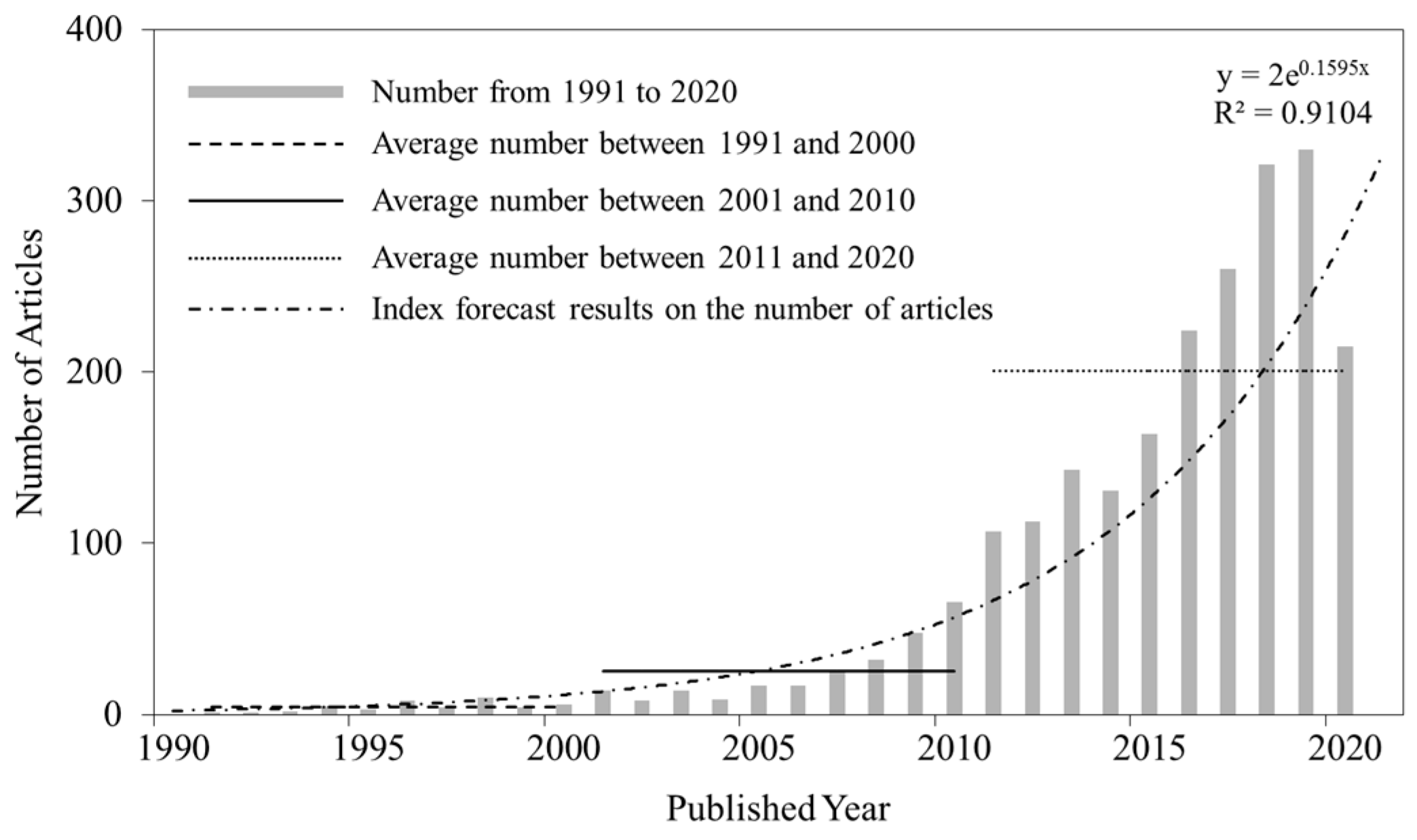
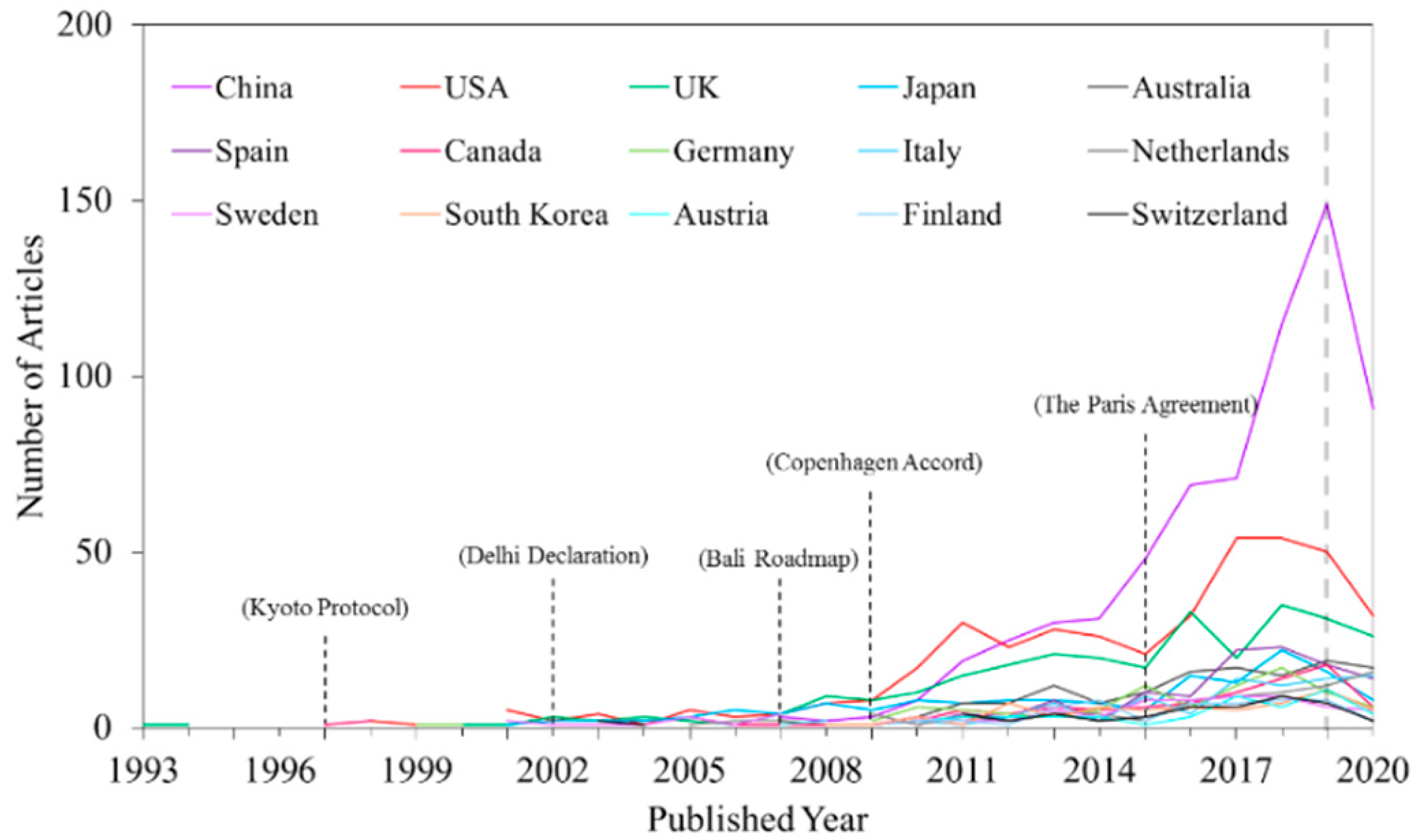


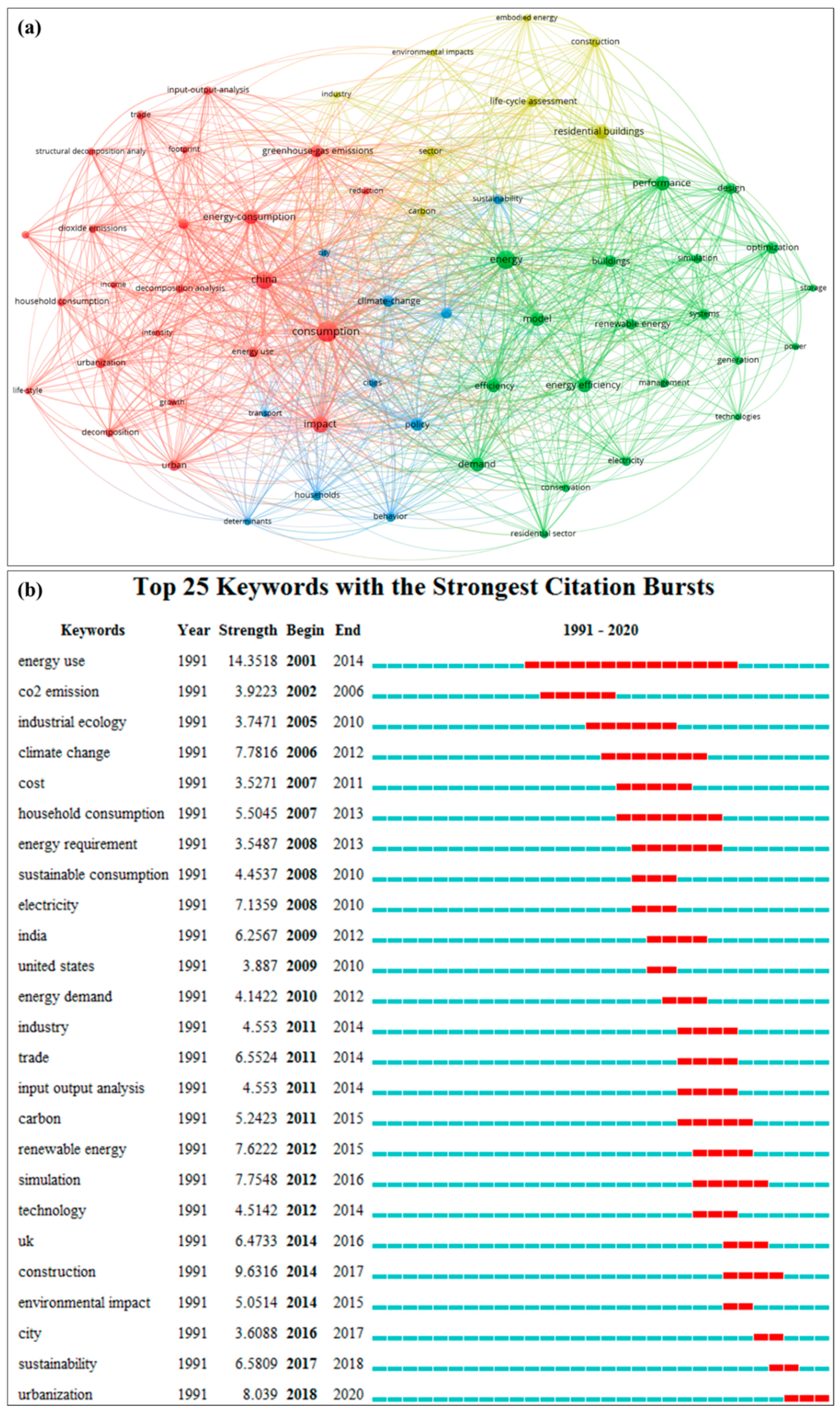
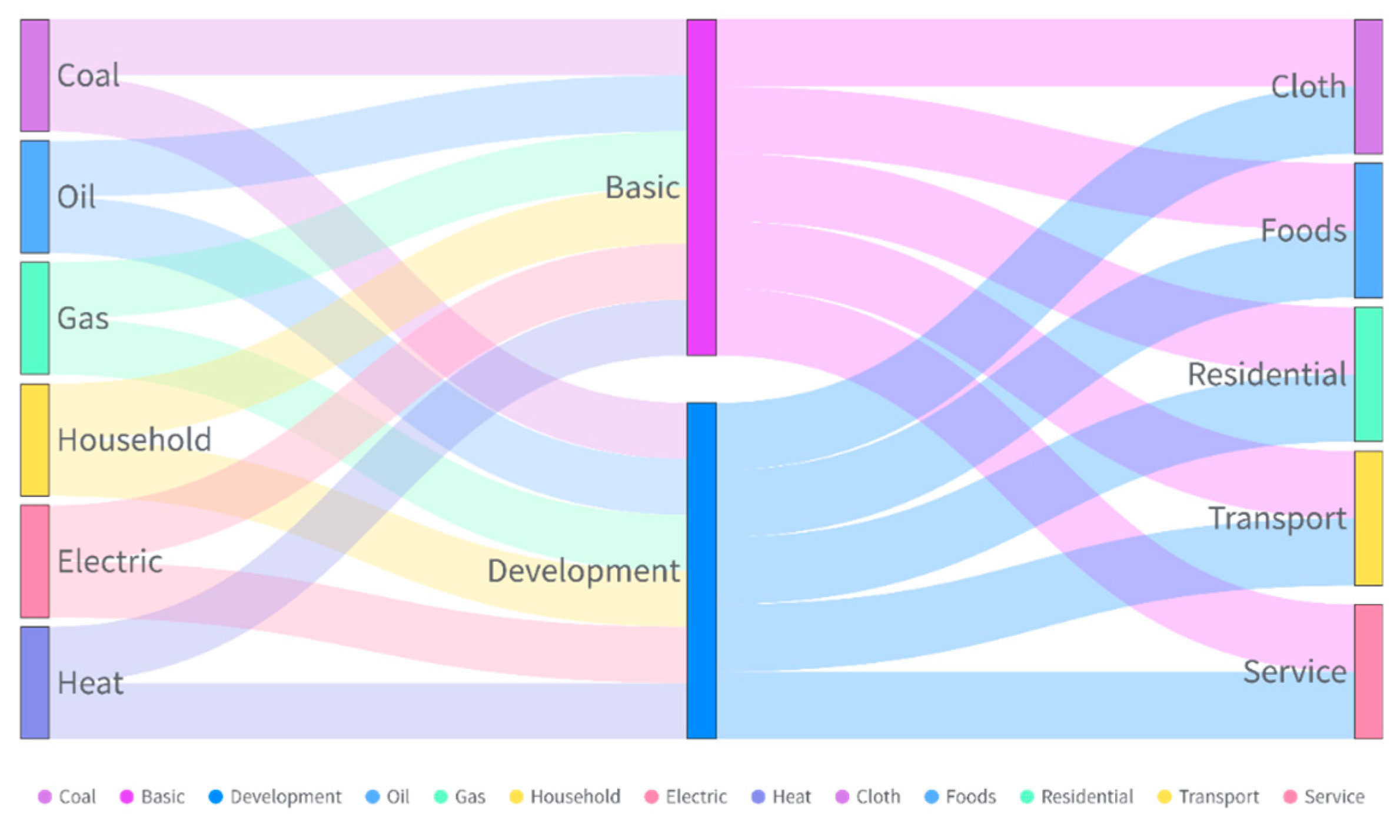
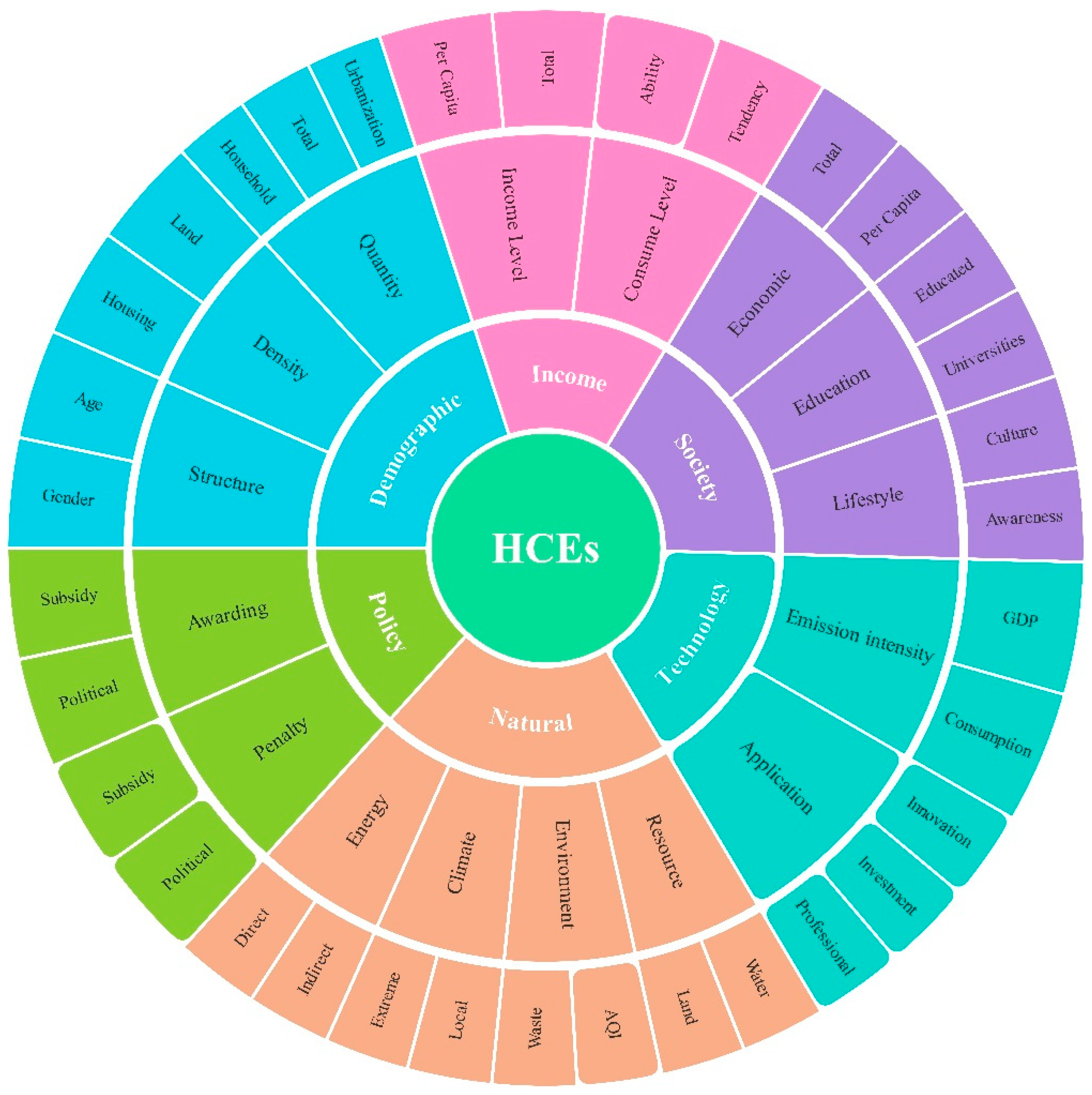
| Rank | Journals | Number | Ratio (%) | Impact Factor | Country |
|---|---|---|---|---|---|
| 1 | Energy Policy | 209 | 8.99 | 5.042 | UK |
| 2 | Journal of Cleaner Production | 186 | 8.00 | 7.246 | UK |
| 3 | Energy and Buildings | 151 | 6.49 | 4.867 | Switzerland |
| 4 | Applied Energy | 125 | 5.37 | 8.848 | UK |
| 5 | Sustainability | 112 | 4.82 | 2.576 | Switzerland |
| 6 | Energy | 104 | 4.47 | 6.082 | UK |
| 7 | Energies | 62 | 2.67 | 2.702 | Switzerland |
| 8 | Energy Economics | 56 | 2.41 | 5.203 | Netherlands |
| 9 | Ecological Economics | 49 | 2.11 | 4.482 | Netherlands |
| 10 | Building and Environment | 44 | 1.89 | 4.971 | UK |
| 11 | Environmental Science & Technology | 31 | 1.33 | 7.864 | USA |
| 12 | Sustainable Cities and Society | 30 | 1.29 | 5.268 | Netherlands |
| 13 | Energy Conversion and Management | 29 | 1.25 | 8.208 | UK |
| 14 | Environmental Science and Pollution Research | 28 | 1.20 | 3.056 | Germany |
| 15 | Science of The Total Environment | 27 | 1.16 | 6.551 | Netherlands |
© 2020 by the authors. Licensee MDPI, Basel, Switzerland. This article is an open access article distributed under the terms and conditions of the Creative Commons Attribution (CC BY) license (http://creativecommons.org/licenses/by/4.0/).
Share and Cite
Liu, L.; Qu, J.; Maraseni, T.N.; Niu, Y.; Zeng, J.; Zhang, L.; Xu, L. Household CO2 Emissions: Current Status and Future Perspectives. Int. J. Environ. Res. Public Health 2020, 17, 7077. https://doi.org/10.3390/ijerph17197077
Liu L, Qu J, Maraseni TN, Niu Y, Zeng J, Zhang L, Xu L. Household CO2 Emissions: Current Status and Future Perspectives. International Journal of Environmental Research and Public Health. 2020; 17(19):7077. https://doi.org/10.3390/ijerph17197077
Chicago/Turabian StyleLiu, Lina, Jiansheng Qu, Tek Narayan Maraseni, Yibo Niu, Jingjing Zeng, Lihua Zhang, and Li Xu. 2020. "Household CO2 Emissions: Current Status and Future Perspectives" International Journal of Environmental Research and Public Health 17, no. 19: 7077. https://doi.org/10.3390/ijerph17197077
APA StyleLiu, L., Qu, J., Maraseni, T. N., Niu, Y., Zeng, J., Zhang, L., & Xu, L. (2020). Household CO2 Emissions: Current Status and Future Perspectives. International Journal of Environmental Research and Public Health, 17(19), 7077. https://doi.org/10.3390/ijerph17197077








